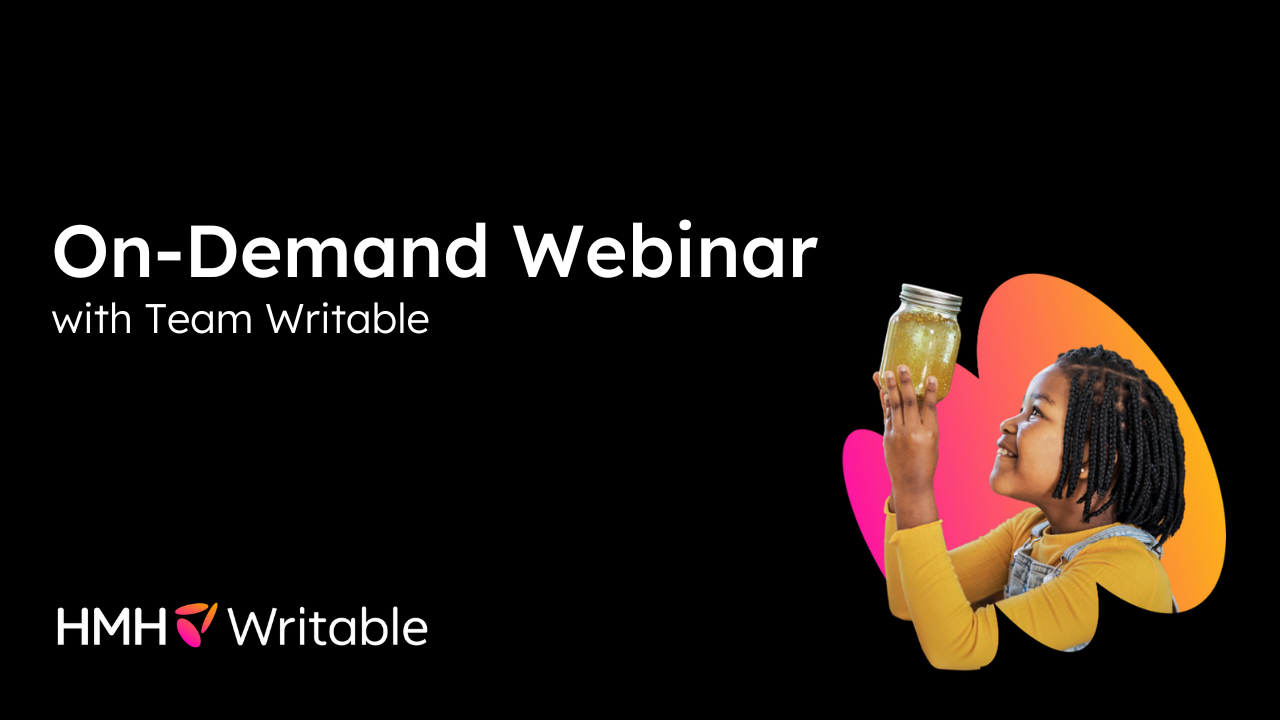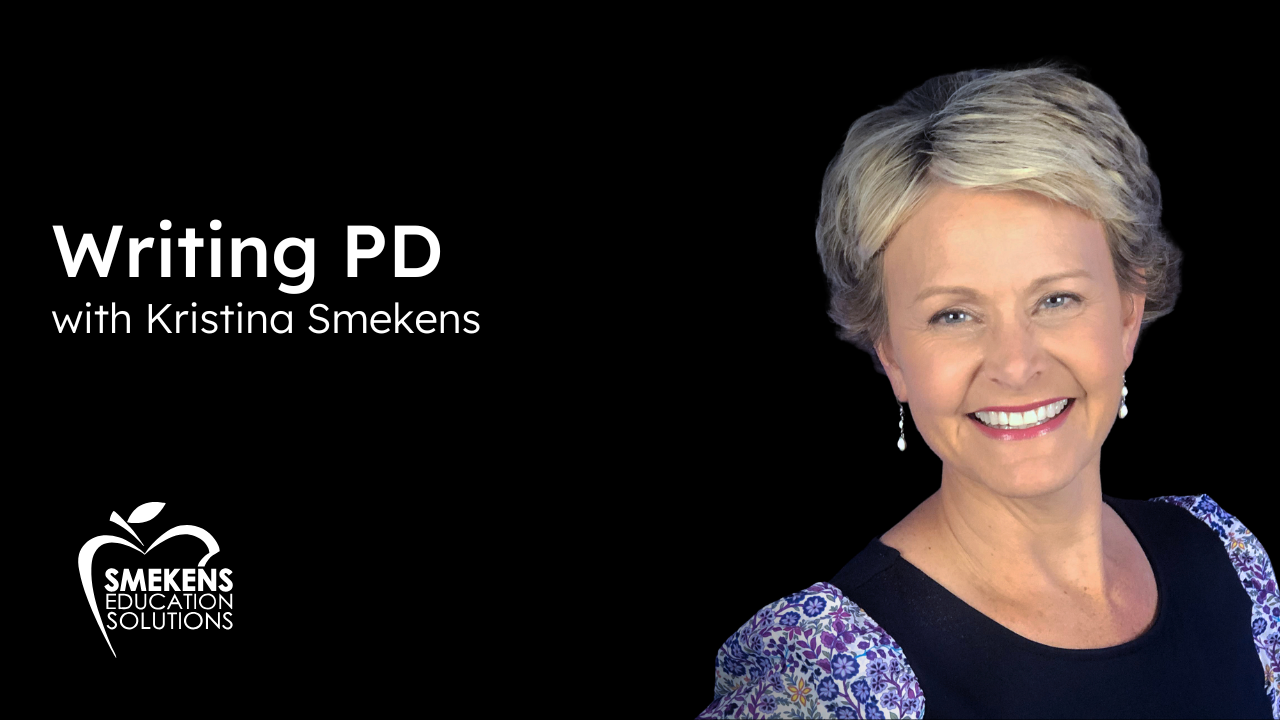No learner is the same, which is why our students often need individual learning plans, customized assignments, and specific supports to help them reach their learning goals. Whether you’re teaching remotely, in a classroom, or in a hybrid between the two, this need is ever present.
Writable is unique in that it allows you to customize learning around both your goals and the time you have available to spend preparing instruction and curriculum. You can take a lighter touch by customizing or creating assignments tailored to your classes, add in more support for individual students with the use of scaffolding via graphic organizers, sentence stems, and additional resources, or take a heavier touch by fully differentiating prompts and/or readings in an assignment based on individual student needs.
While all students benefit from customized learning, students with accommodations, such as students with IEP’s or 504’s, and English language learners, are often required to have differentiated levels of support. With Writable, this is possible, even when your students are learning from home.
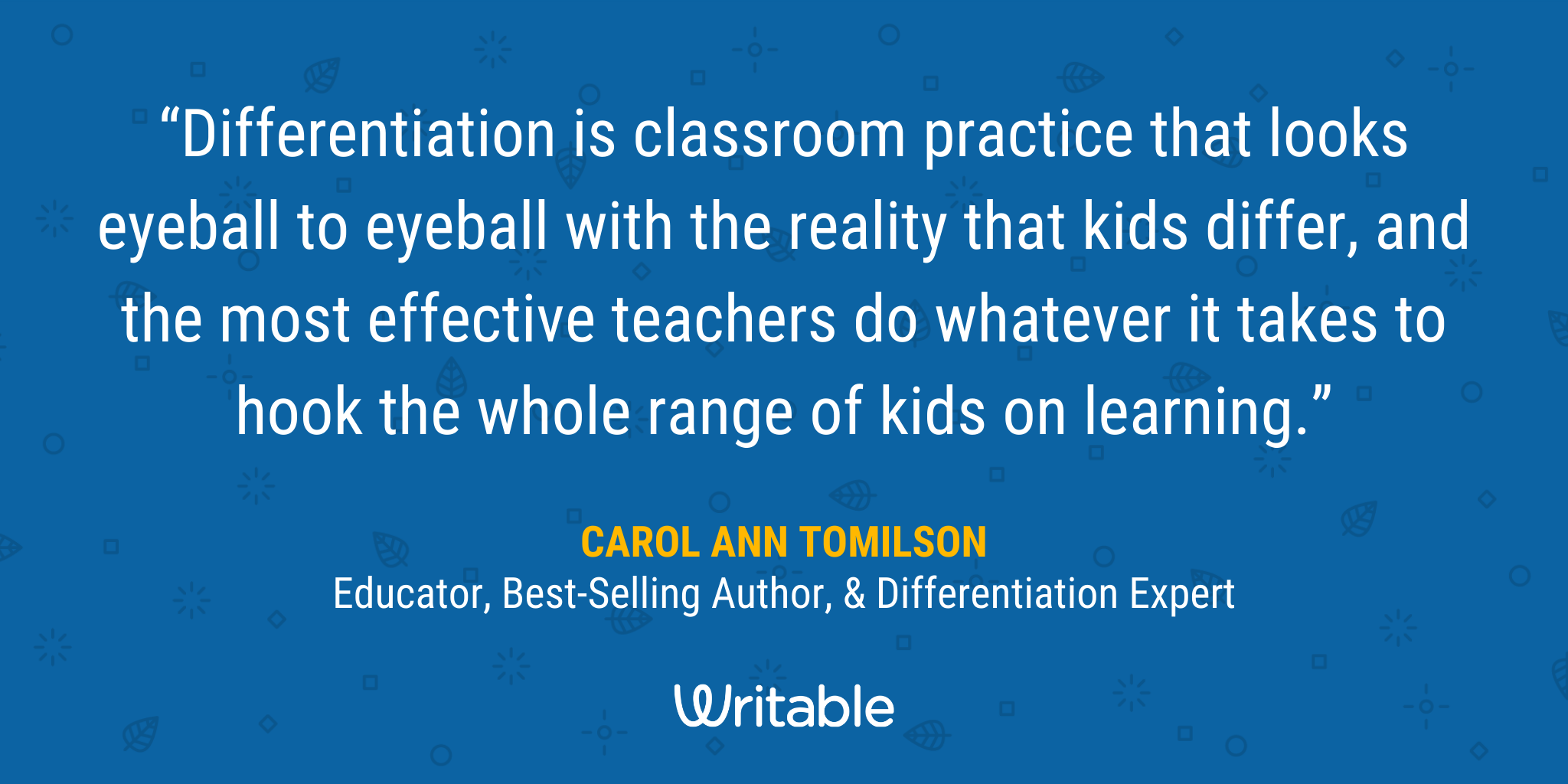
What is Differentiation, Exactly?
Differentiation is often confused with, or used synonymously with personalization and individualization of learning. But differentiation has some key and important differences. For clarity, when we talk about personalization we are talking about students having their own, unique learning goals. When we discuss individualization, we’re talking about the differing pace at which students move towards a shared learning goal.
With differentiated instruction, learning goals remain the same for groups of students, but the materials they are working on, and the methods being used to instruct, are tailored for their unique learning needs. Content, process, or environment can be differentiated, and ongoing assessment and adjustment are crucial aspects of differentiated instruction in the student-centered classroom.

Writable is designed to help you focus on two specific areas of differentiation: content and process.
Content
These are the materials a student needs to learn or have access to in order to gain needed information. What does differentiated content in Writable look like?
- Reading passages at varying Lexile levels. Add your own readings or PDFs to any premade Writable assignment, or check out our Cricket Collection or Time for Kids Collection, which include leveled readings for elementary and middle school students.
- Adaptations made to the same reading passage. Vocab words might be bolded or linked to visual image.
- Adaptations to the same writing prompt. Some prompts may contain more information or vary by difficulty.
- Organizers added to assignments. Some students may have access to organizers to help them plan and draft their writing.
- Sentence stems added to assignments. Especially helpful for English learners, sentence stems can guide a student’s understanding of the assignment and support their progression towards a shared class learning goal.
- Additional resources added to assignments. Attaching a PDF, vocabulary lists, or link in an educational video from YouTube.
Process
These are the activities and methods through which a student engages in order to make sense of or master the content. What do differentiated processes look like in Writable?
- Different levels of scaffolded supports. Some students may gain access to graphic organizers, multiple choice questions, or sentence stems.
- Audio or video instruction. Not all students learn best through purely written instruction. Especially when not live in the classroom, using audio or video to record an instructional lesson in any Writable assignment can help to remind, reinforce, and engage students.
- Audio or video feedback. Students thrive when a personal connection is created or reinforced. Connect with your students in a personal way by recording an audio or video message while grading.
- Live Feedback. This feature in Writable allows you to reach students in the moment while they write to facilitate conferencing and causal feedback.
- Adaptations made to directions and instructions. When differentiating assignments you can choose to provide differing information, offer different instructional strategies, or create levels of complexity in your instructions.
- Benchmark assessments. Not only can students practice writing and learn how to give feedback in Writable, but you can use data to assess or run assessments in Writable. Assessing student progress in order to adjust learning supports is a key component to differentiating instruction.
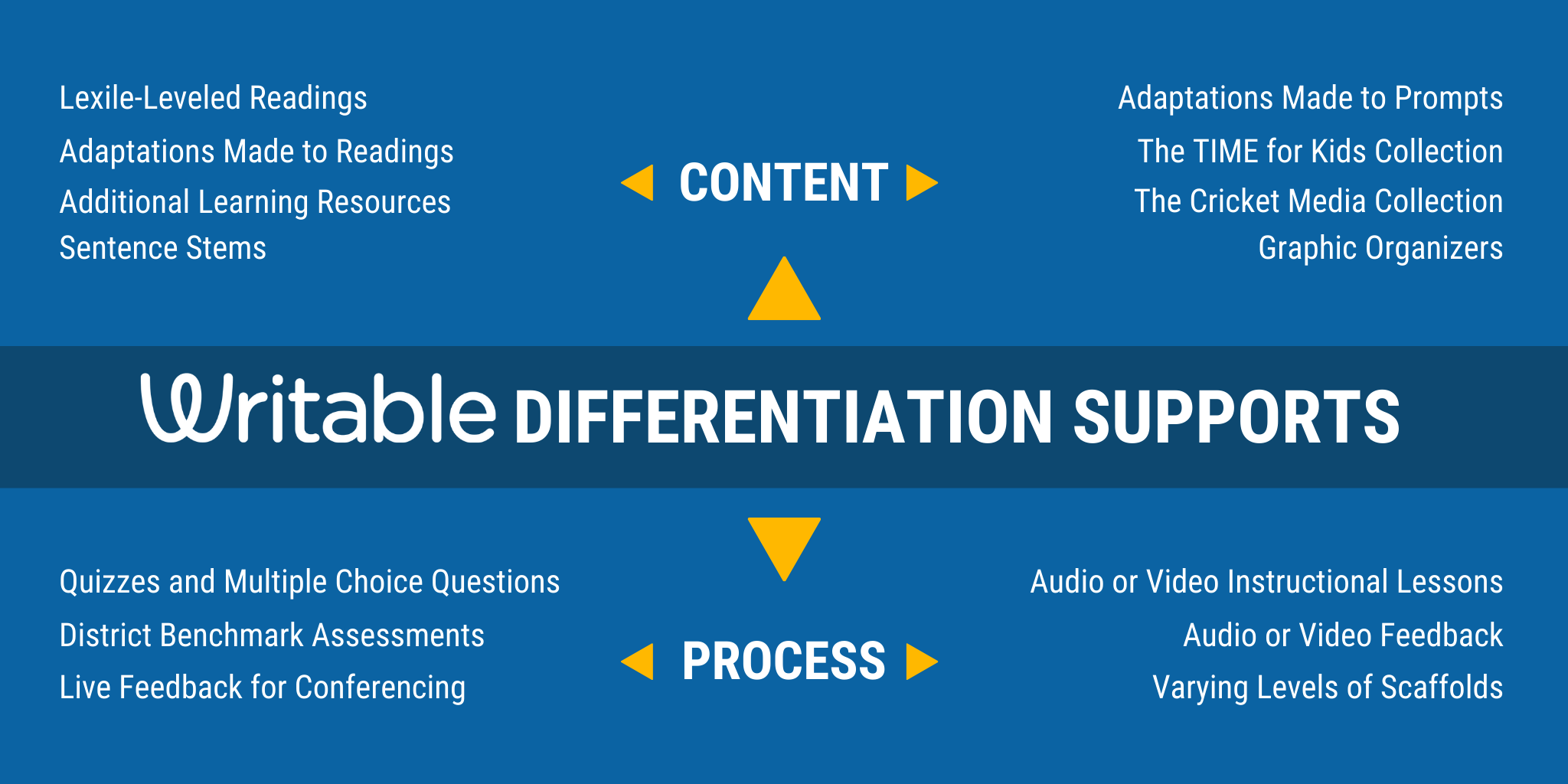
Are you new to customizing learning or unsure where to start with Writable? Keep reading for a step by step guide!
Step 1: Decide Your Differentiation Goal
How much time do you have to customize learning? What is the overall learning goal for your students? How can you work backwards from that goal to help each student reach their full potential?
Whether you’re teaching in person, remotely, or in a hybrid model, these are important questions to ask yourself when choosing how you’re going to customize learning. They will help you determine the differentiation path in Writable that is best for you and your students.
Step 2: Choose Your Differentiation Path
Customize by Class (Minimal Time)
- Choose from 600+ pre-made assignments in Writable that fit learning goals (like assignments from the Cricket Media Collection, the TIME for Kids Collection, Skills Activities, State Assessments, assignments with organizers, assignments for English learners, and more).
- Treat assignments like templates and edit them by changing the reading, adding a PDF or video link, recording an instructional lesson, writing additional prompts, or editing directions.
- Choose from pre-made rubrics, like state-specific or standard-specific rubrics, edit Writable rubrics, create your own rubric, upload a custom district rubric.
- Create an assignment from scratch.
- Add a Writable organizer or upload your own graphic organizer to any assignment.
- Add sentence stems for all students (great for elementary).
- Edit the explanations students see when choosing between scores on a rubric during self and peer review.
- Add multiple choice questions to any assignment.
- Pick from already differentiated assignments in Writable (Differentiated Content with TIME for Kids Articles and English 3D by Dr. Kate Kinsella).
Add Scaffolding for Some Students (Moderate Time)
- For only some students: add in a graphic organizer, multiple choice questions, or additional resources.
- For only some students: add in sentence stems (great for English learners).
- For only some students: add in additional instructional strategies or vary the difficulty of the directions for an assignment.
Fully Differentiate Instruction (Maximum Time)
- Differentiate readings by using or creating different levels of difficulty and/or Lexile levels of readings with any assignment.
- Differentiate prompts so that some may or may not include instruction support, some may be easier than others using the same reading, etc.
- By using all the features previously described, create multi-level assignments. For instance, create a differentiated assignment which has maximum, moderate, and minimum levels of complexity.
- Group students by using the create class feature (or sync already made group rosters from within your LMS or Google Classroom) and very assignments by group.
Step 3: Get Creative
Now that you’ve decided how you’re going to customize learning, it’s time to create in Writable! Luckily everything is editable and changeable, so if you want to add more customization, scaffolding, or differentiation later, you can always continue working on your creation.
If you’re fully differentiating assignments we suggest that you create one level, for instance an assignment with a moderate level of complexity, then duplicate and edit to create minimum and maximum levels of complexity for the overall assignment.
Click here for more in-depth directions on differentiating an assignment.
If you’re looking for additional support while you create, check out our Help Center, use the Live Chat feature in Writable for on-demand support, or email support@writable.com.
Step 4: Assess & Adjust
Differentiation is a journey, and one of the most important tenets of differentiation is regular assessment of student learning, and adjustment of a student’s learning materials to help them continue to reach towards the common learning goal. Because Writable is a fluid, dynamic, and easily customizable platform that automatically measures student writing progres for you, all the tools you need for this final step are inside Writable.
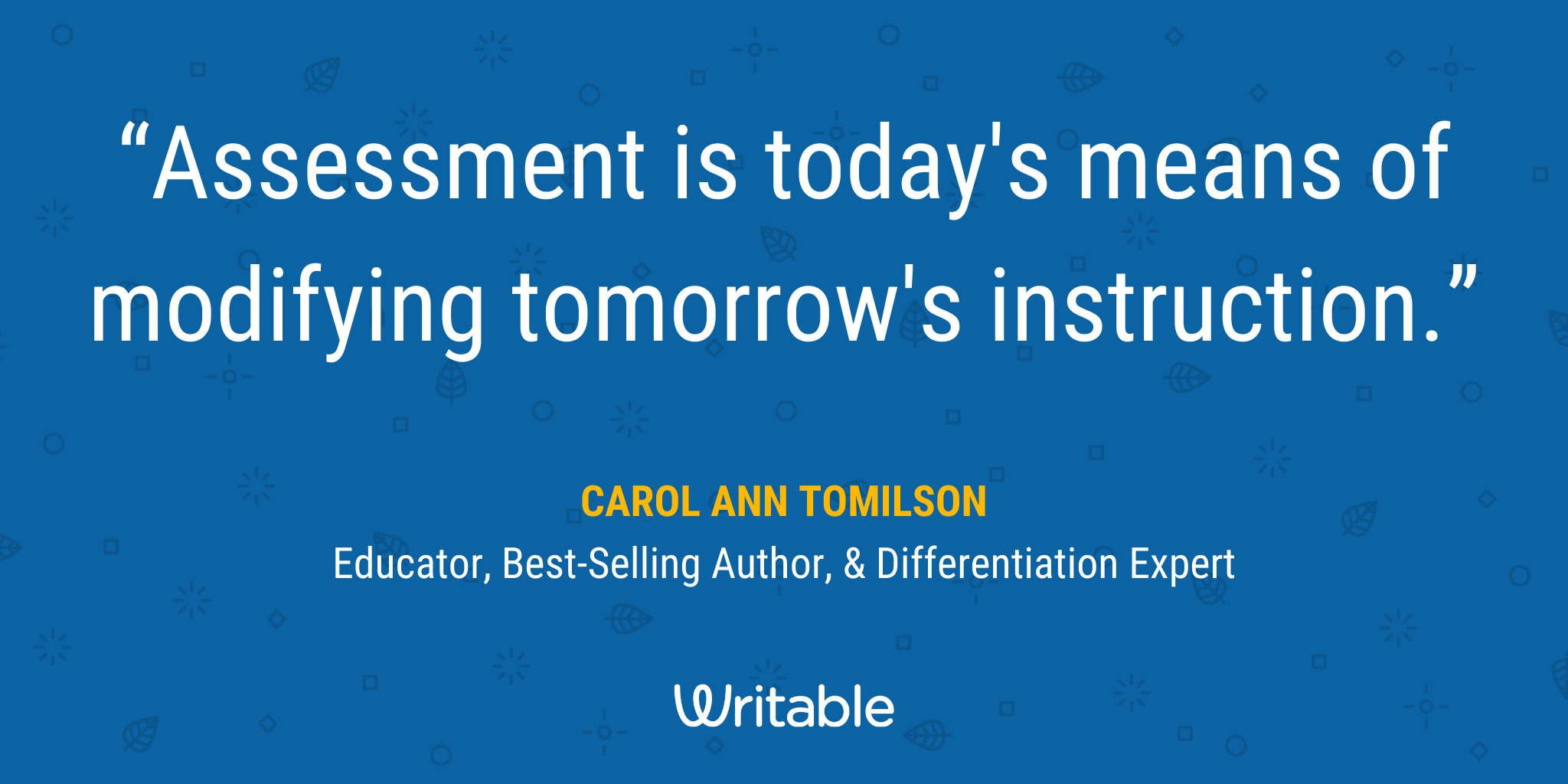
Whether you’re using Writable to run assessments, or for informally assessing students using the comprehensive data gathered as they write and review, knowing how your students are growing as writers over time, and where students may need individual and targeted support, is essential.
When using student growth data in Writable you can access it in one of two ways: from an assignment dashboard for assignment-specific insights on an individual student or whole group, and from the ‘Report’ page, for comparing growth data over time for an individual, group, or multiple groups of students.
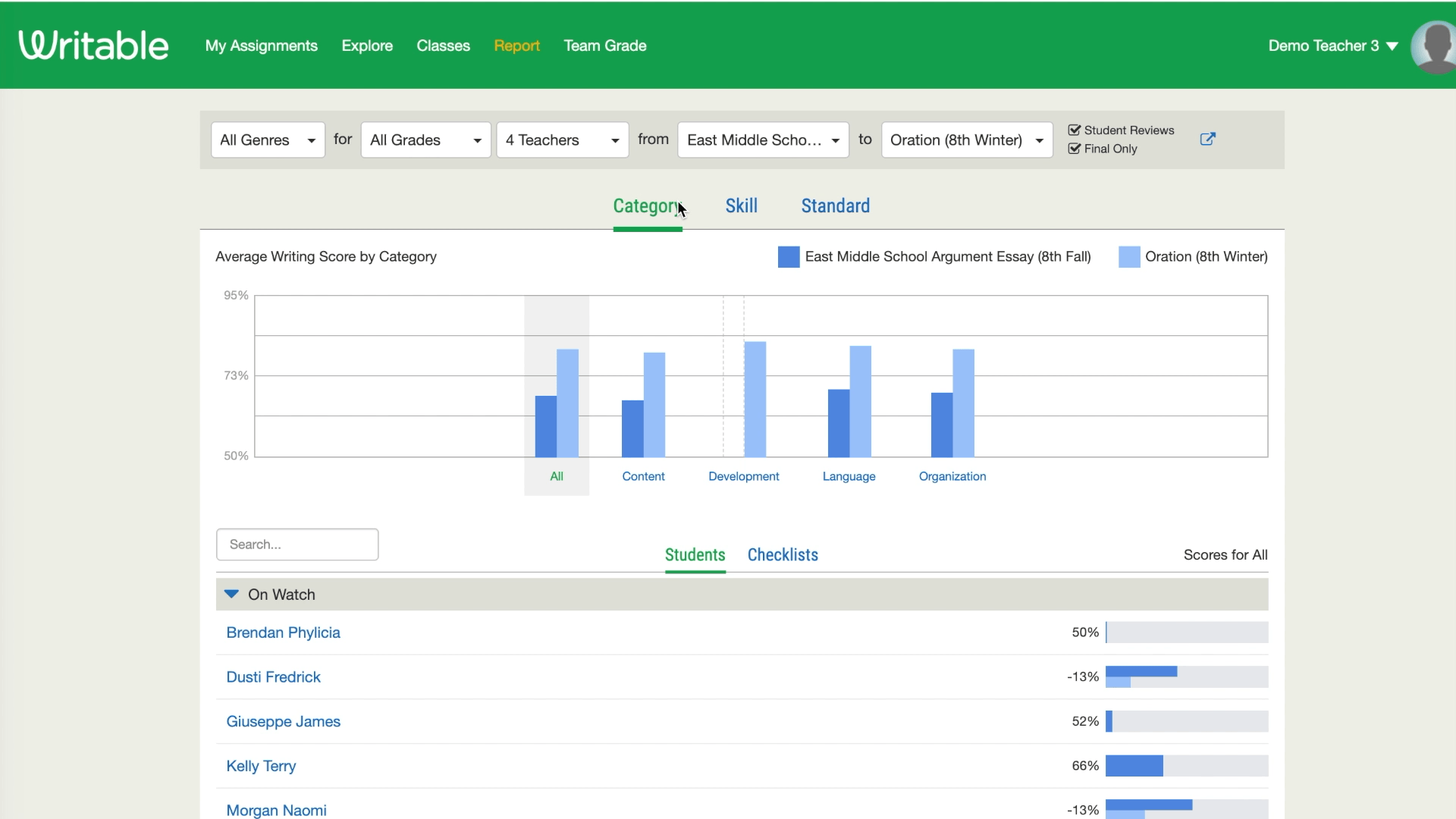
The success data you’re shown in Writable, organized by Standard, Category, and Skill, will help you to not only assess student performance, but fold learning back into your curriculum, whole and small group instruction, and overall learning goals. With Writable you can continue assessing, adjusting, and iterating on your curriculum and instruction as you continue to support your students on their journey to becoming great writers.
Do you love what you’ve created in Writable? Sharing it with your colleagues or PLN is easy. Click here to learn how to share your customized or original assignments with others!
![]()
Are you new to Writable or curious to learn more? Create a free teacher account, check out our pricing, schedule a personalized demo, or Join the Writable Educators Facebook Community.

